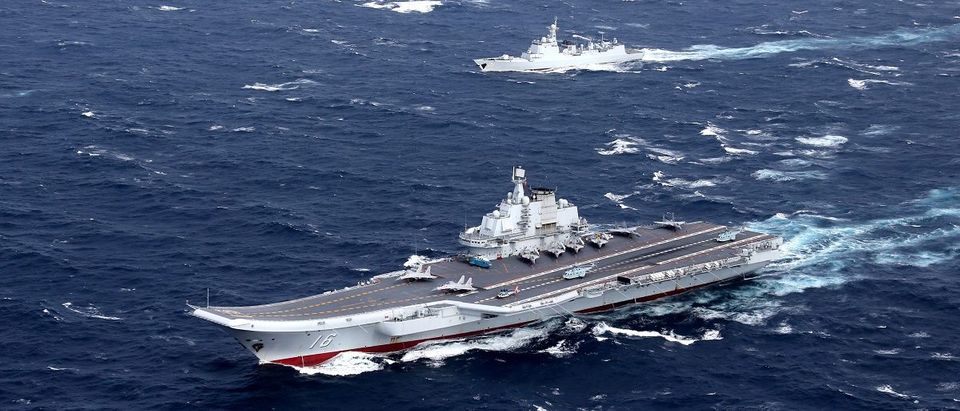China is pursuing regional dominance, and the South China Sea is a key battleground in that struggle, according to three mid-level Chinese naval officers.
Lt. Commander Jin Jing, a researcher at the Naval Research Institute, and Commanders Xu Hui and Wang Ning, political officers for the South Sea Fleet of the People’s Liberation Army Navy, offered insight into China’s strategic intentions for the South China Sea in an issue of Naval Studies, a Chinese military periodical for international distribution.
Japan’s Kyodo News reported on the the article earlier this year, but the report was short on meaningful information. The Chinese article was recently tracked down and analyzed by Ryan Martinson, an assistant professor at the China Maritime Studies Institute of the U.S. Naval War College, and Capt. Katsuya Yamamoto, a Japan Maritime Self-Defense Force (JMSDF) Liaison Officer and International Military Professor at the U.S. Naval War College.
Asserting what Chinese officials often publicly deny, the three Chinese naval officers argued “the struggle in the South China Sea is not just about contention over rights and interests. More than that, it is a struggle for dominance in regional security affairs.” China sees an opening as the pivot to Asia that began during the Obama administration fell apart.
The authors call on China to continue to wage a “protracted war” for the region, a “long-term, patient and comprehensive contest to master the strategic initiative.” China has been significantly expanding its military presence in the contested South China Sea through the development of armed outposts in the area, especially in the Spratly Islands.
“China appears to have built significant point-defense capabilities, in the form of large anti-aircraft guns and probable close-in weapons systems (CIWS), at each of its outposts in the Spratly Islands,” the Asia Maritime Transparency Initiative, a Center for Strategic and International Studies project, introduced in a report in December.
With “the expansion of Chinese facilities in the Spratlys, China gained a certain initiative in terms of military security. As time goes on, the balance of power will tilt in China’s favor,” the three Chinese naval officers observed.
In addition to the construction of military outposts, China also advances its interests in the South China Sea through the deployment of its maritime militia.
“China has used coercive tactics, such as the use of law enforcement vessels and its maritime militia, to enforce maritime claims and advance its interests in ways that are calculated to fall below the threshold of provoking conflict,” according to the 2017 China Military Power report produced by the Pentagon.
The authors of the Chinese article made a reference to the strategy, referring to it as “sending civilians first, and following them with the military” and “concealing the military among civilians.”
The naval officers see crises as opportunities for China to flex its muscles and “savagely strike others where it hurts.” In particular, China targets weaker claimant states, punishing one to intimidate earlier, a coercive tactic rooted in Chinese thinking and the Chinese idiom “killing the chicken to scare the monkeys.”
While China is actively seeking dominance, according to the writers, Beijing continues to attribute escalation of tensions in the region to the U.S., which has increased its direct military involvement in the area since 2015, when the U.S. began conducting freedom-of-navigation operations to challenge China’s claims. The U.S. has also conducted carrier patrols and joint military drills in the region. Nonetheless, the Chinese naval officers do not anticipate armed conflict over the South China Sea, asserting that the bilateral relationship between China and the U.S. may come under stress, but will ultimately persist despite occasional increases in tension.
China perceives U.S. pressure as a response to China’s rise, which it believes touches “a raw nerve in American hegemony.”
While this one article does not detail all of China’s strategic interests in the disputed South China Sea, it does offer a better look at what China hopes to achieve and potentially reveals evidence of China’s extremely coercive ambitions.
The authors suggest that China should use political, economic, and diplomatic means to engage Southeast Asian nations to “divide and disrupt” power blocs designed to challenge China’s authority, as well as highlight China’s bottom lines, demonstrate China’s military power, and employ coercive tactics.
Send tips to ryan@
All content created by the Daily Caller News Foundation, an independent and nonpartisan newswire service, is available without charge to any legitimate news publisher that can provide a large audience. All republished articles must include our logo, our reporter’s byline and their DCNF affiliation. For any questions about our guidelines or partnering with us, please contact licensing@dailycallernewsfoundation.org.


